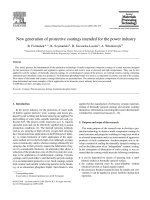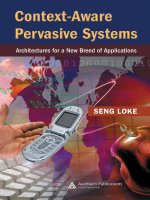New approaches of management for apple blossom thrip (ABT) in apple orchards of Kashmir valley
Bạn đang xem bản rút gọn của tài liệu. Xem và tải ngay bản đầy đủ của tài liệu tại đây (274.03 KB, 8 trang )
Int.J.Curr.Microbiol.App.Sci (2019) 8(1): 1573-1580
International Journal of Current Microbiology and Applied Sciences
ISSN: 2319-7706 Volume 8 Number 01 (2019)
Journal homepage:
Original Research Article
/>
New Approaches of Management for Apple Blossom Thrip (ABT) in Apple
Orchards of Kashmir Valley
Muneer Ahmad*, M. Ayoub Manto, Sajad Mohu Din and S.S. Pathania
Division of Entomology, Sher-e-Kashmir University of Agricultural Sciences and Technology,
Shalimar Srinagar, Kashmir, J&K 190025, India
*Corresponding author
ABSTRACT
Keywords
Bio-efficacy,
Orchards,
Thiocloroprid,
Apple blossom
thrips
Article Info
Accepted:
12 December 2018
Available Online:
10 January 2019
Apple blossom thrips (Thysanoptera: Thripidae) is serious pest of apple bloom in some
areas of Bandipora and Anantnag of kashmir valley. A field trials were laid out at
Dangerpora Kullar, Luckbown (District Anantnag) and Arin and bagh (District Bandipora)
in a completely Randomized Block Design during 2015 - 2017. Apple trees of variety
“Red Delicious”, 13-16 years of age were selected for the field trial. The highest pest
incidence (5-8) thrips per flower was recorded in Madar bandipora. The spraying of the
treatments, viz., Thiochloroprid @ 0.3, 0.4 and 0.5 ml/L of water, chlorpyriphos 20 EC @
0.02%, dimethoate 30 EC @ 0.05% and water as control. The overall bio efficacy of the
insecticides evaluated against apple blossom thrip (ABT) was in the order of Code 188
(0.5 ml/L) > chlorpyriphos 20 EC (0.02%) > dimethoate 30 EC (0.05%) > Code
thiocloroprid (0.4 ml/L) > thiocloroprid (0.3 ml/L). While comparing the bioefficacy of the
treatments on fruit yield (A Grade-fruit boxes / tree), the order of efficacy was
thiocloroprid (0.5 ml/L) > dimethoate 30 EC (0.05%) > thiocloroprid (0.4 ml/L) >
chlorpyriphos 20 EC (0.02%) > thiocloroprid (0.3 ml/L).
Introduction
Apple
blossom
Thrip
(Thysanoptera:
Thripidae) damages the fruit of a number of
crops. Apple blossom thrip is one of the
alarming pests of apple (Malus domestica
Borkh) in Kashmir. Feeding by young
nymphs and adults produces distinct
symptoms on flower petals as they have
rasping type of mouth parts. The female parts
of the flower are affected by the pest with the
result fruit setting is reduced drastically. The
traditional method of sampling apple
blossoms to check for numbers of thrips is to
examine samples of buds, pulling them apart
and shaking them onto a white paper or
Vaseline – smeared Petri-dish. Many factors
have to be taken into consideration when
determining an economic threshold for thrips.
Chemical control is one of the most effective
and practical method available to the
orchardists for the effective control of apple
blossom thrip (ABT). For the last few years,
the pest has been appearing in alarming form
in most apple growing areas, suck sap from
the flowers resulting in reduced fruit set and
huge economic losses to apple. The bioefficacy of various insecticides against the
1573
Int.J.Curr.Microbiol.App.Sci (2019) 8(1): 1573-1580
pest, were evaluated in district Anantnag and
Bandipora Kashmir for the first time and the
results are presented here.
Materials and Methods
A field trials were laid out at Dangerpora
Kullar and Luckbown (District Anantnag) and
Arin and bagh bandipora (District bandipora)
in a completely Randomized Block Design
during 2015 - 2017, respectively. Apple trees
of variety “Red Delicious”, 13-16 years of
age were selected for the field trial. The
survey was conducted in hot pockets of two
districts
where
apple
orchards
are
infested.The spraying of the treatments, viz.,
Thiocloroprid @ 0.3, 0.4 and 0.5 ml/L of
water, chlorpyriphos 20 EC @ 0.02%,
dimethoate 30 EC @ 0.05% and water as
control, each replicated four times with a
single tree as a replicate, was done with the
help of a power sprayer at pink bud stage and
the observations on the number of apple
blossom thrips (ABT) per cluster of flowers
before and after the treatment applications
were counted at subsequent intervals of 1st,
3rd, 5th, 7th and 10th day after treatment (DAT)
by taking a random sample of four clusters
from outer, middle and innermost parts of the
tree canopy. Per cent mortality was worked
out by computing the difference between pre
and post treatment populations of the apple
blossom thrip (ABT) by applying Abbot’s
(1925) formula. The observations on the fruit
yield (fruit boxes / tree) were recorded after
harvest of the apple crop from the
experimental trees. The data was subject to
analysis of variance and critical difference at
5% level of significance was worked out. The
yield of A-Grade boxes per treatment was
recorded at the time of harvest.
Results and Discussion
The incidence of Apple blossom thrips were
recorded in different places which are hot
pockets of this insect pest. The highest pest
incidence was recorded in Madar which
recorded 5-8 thrips /flower which is more
than ETL level of the pest followed by Arin
Bandipora which recorded 5-7 thrips/flower
while as least 3-5 thrips/flower were recorded
in Dangerpora ananthnag Kashmir (Table 1).
Bio-efficacy of Thiocloroprid against Apple
blossom Thrip on apple at Arin
(Bandipora) during 2015
Amongst the insecticides, Thiocloroprid
resulted 51.11, 74.33, 83.33 and 93.66%;
48.26, 74.37, 87.11, 87.11 and 94.95%; 52.62,
76.46, 84.49, 89.74 and 93.66% mortality of
the apple blossom thrip population at 0.3, 0.4
and 0.5 ml/L of water in comparison to check
(3.09, 3.09, 6.09, 6.09 and 9.09%) 1st, 3rd 5th,
7th and 10th DAT, respectively. Similarly
chlorpyriphos 20 EC and dimethoate 30 EC
resulted 55.55, 73.88, 82.12, 90.87 and 46.83,
74.33, 81.66, 81.66 and 97.91% mortality of
apple blossom thrip population at 0.02 and
0.05% concentrations at 1st, 3rd 5th, 7th and
10th DAT. Thiocloroprid @ 0.5ml/ lit. of
water resulted highest mean mortality
(80.19%) Whereas, least mean percent
mortality (71.7%) at 0.3ml/ lit of water while
as Thiocloroprid exhibited 78.38 % mean
mortality @ 0.4ml/litre of water. All the
treatments were statistically different from
control (Table 2).
Bio-efficacy of against apple blossom thrip
on apple at Arin (Bandipora during 2016)
Amongst the insecticides, Thiocloroprid
resulted 20.77, 63.00, 77.77, 81.55 and
92.66%; 23.09, 61.59, 80.83, 80.83 and
92.37%; 33.33, 66.06, 87.77, 88.88 and
95.66% mortality of the apple blossom thrip
(ABT) population at 0.3, 0.4 and 0.5 ml/L of
water in comparison to check (6.00, 7.00,
8.00, 10.33 and 11.33%) 1st, 3rd 5th, 7th and
10th
DAT,
respectively.
Similarly
1574
Int.J.Curr.Microbiol.App.Sci (2019) 8(1): 1573-1580
chlorpyriphos 20 EC and dimethoate 30 EC
resulted 43.71,71.85,81.23,87.52 and 96.90%;
35.69,67.84,78.56,89.28
and
92.92%
mortality of apple blossom thrip population at
0.02 and 0.05% concentrations at 1st, 3rd 5th,
7th and 10th DAT, respectively. Amongst
thiocloroprid @ 0.5ml/ lit. of water resulted
highest mean mortality (79.34%) Whereas,
least mean percent mortality (67.15%) at
0.3ml/ lit of water while as thiocloroprid
exhibited 67.75 % mean mortality @
0.4ml/litre of water. All the treatments were
statistically different from control (Table 3).
Bio-efficacy of Thiocloroprid against Apple
blossom thrip on apple at Dangerpora
Kullar (Anantnag) during 2015
Amongst the insecticides, Thiocloroprid
resulted 76.88, 84.95, 90.66, 95.45 and
98.48%; 86.89, 91.46, 94.48, 99.26 and
100%; 93.08, 95.90, 99.36, 100 and 100%
mortality of the apple blossom thrip
population at 0.3, 0.4 and 0.5 ml/L of water in
comparison to check (38.17, 28.57, 23.08,
21.12 and 18.51%) 1st, 3rd 5th, 7th and 10th
DAT, respectively. Similarly chlorpyriphos
20 EC and dimethoate 30 EC resulted 88.68,
94.12, 96.73, 99.54 and 100%; 88.80, 94.20,
98.64, 100 and 100% mortality of apple
blossom thrip population at 0.02 and 0.05%
concentrations in comparison to check (38.17,
28.57, 23.08, 21.12 and 18.51%) 1st, 3rd 5th,
7th and 10th DAT, respectively (Table 4 and
Fig. 1).
Bio-efficacy of Code 118 against apple
blossom thrip on apple at Luckbown
(Anantnag) during 2017
Amongst the insecticides, thiocloroprid
resulted 79.16, 85.64, 91.14, 94.35 and
98.14%; 86.08, 90.62, 96.26, 98.73 and
100%; 91.17, 95.93, 98.90, 100.00 and 100%
mortality of the apple blossom thrip
population at 0.3, 0.4 and 0.5 ml/L of water in
comparison to check (29.30, 25.28, 21.99,
19.19 and 15.72%) 1st, 3rd 5th, 7th and 10th
DAT, respectively. Similarly chlorpyriphos
20 EC and dimethoate 30 EC resulted 89.63,
93.94, 98.27, 99.43 and 100%; 86.65, 92.43,
96.93, 99.38 and 100% mortality of apple
blossom thrip population at 0.02 and 0.05%
concentrations in comparison to check (29.30,
25.28, 21.99, 19.19 and 15.72%) 1st, 3rd 5th,
7th and 10th DAT, respectively (Table 5 and
Fig. 2).
Table.1 Status of Apple blossom thrip (ABT) in apple orchards of Kashmir
S.No
Location
Range
Incidence/flower
1
Madar bandipora
5-8
2
Arin Bandipora
5-7
3
Bagh bandipora
5-6
4
Dangerpora Kullar, anantnag
3-5
5
Luckbown,anantnag
3-6
1575
Int.J.Curr.Microbiol.App.Sci (2019) 8(1): 1573-1580
Table.2 Bioefficacy of different pesticides against apple blossom thrip infesting apple variety
Red Delicious at Arin in District Bandopora during 2015
Pesticide
Conc.
(ml/L)
Pre
treatment
Count/clu
ster of
flowers
*Mean percent mortality of blossom thrip population over pre
treatment
Pooled
mean
Days after pesticide treatment
1st
3rd
5th
7th
10th
0.3
12.33
51.11
(45.63)
74.33
(59.55)
83.33
(65.90)
86.10
(68.11)
93.66
(75.41)
77.70
0.4
13.00
12.66
0.02%
11.66
0.05%
11.66
check
11.00
74.37
(59.37)
76.46
(59.76)
73.88
(59.26)
74.33
(59.55)
3.09
(10.11)
2.04
87.11
(68.95)
84.49
(66.80)
82.12
(64.98)
81.66
(64.64)
6.09
(14.28)
1.56
87.11
(68.95)
89.74
(71.31)
90.87
(72.41)
81.66
(64.64)
3.09
(10.11)
1.98
94.95
(77.01)
93.66
(75.41)
96.29
(78.89)
97.91
(81.62)
9.09
(17.53)
2.76
78.38
0.5
48.26
(44.26)
52.62
(46.50)
55.55
(48.18)
46.83
(43.18)
3.09
(10.11)
1.67
Thiocloroprid
Chlorpyriphos
20 EC
Dimethoate 30
EC
Water
CD at 5%
80.19
79.74
76.47
4.89
Table.3 Bioefficacy of different pesticides against apple blossom thrip infesting apple variety
Red Delicious at Arin Bandipora during 2016
Pesticide
Conc.
(ml/L)
0.3
9.00
0.4
8.66
0.5
9.00
0.02%
10.66
0.05%
9.33
check
9.33
Thiocloropr
id
Chlorpyrip
hos 20 EC
Dimethoate
30 EC
Water
Pre
treatme
nt
Count/cl
uster of
flowers
*Mean percent mortality of blossom thrip population
over pre treatment
Pooled
mean
Days after pesticide treatment
1st
3rd
5th
7th
10th
20.77
(27.10)
23.09
(28.71)
33.33
(35.25)
43.71
(41.38)
35.69
(36.68)
0.00
2.67
63.00
(52.52)
61.59
(51.59)
66.06
(54.35)
71.85
(57.95)
67.84
(55.44)
0.00
2.04
77.77
(61.86)
80.83
(64.02)
87.77
(70.86)
81.23
(64.31)
78.56
(62.41)
0.00
1.76
81.55
(64.45)
80.83
(63.92)
88.88
(70.40)
87.52
(69.19)
89.28
(70.76)
0.00
1.38
92.66
(73.95)
92.37
(74.27)
95.66
(74.27)
96.90
(79.85)
92.92
(74.53)
0.00
2.10
CD at 5%
1576
67.15
67.75
79.34
72.85
72.87
0.00
Int.J.Curr.Microbiol.App.Sci (2019) 8(1): 1573-1580
Table.4 Bioefficacy of different pesticides against apple blossom thrip infesting apple variety
Red Delicious at Dangerpora Kullar in District Anantnag during 2015
Pesticide
Conc.
(ml/L)
0.3
Thiocloroprid
0.4
0.5
Chlorpyriphos
20 EC
Dimethoate 30
EC
Water
0.02%
0.05%
check
CD at 5%
Pre
treatment
Count/cluster
of flowers
9.62
(3.09)
11.31
(3.35)
11.19
(3.34)
10.37
(3.21)
12.81
(3.57)
10.87
(3.29)
2.67
(0.40)
*Mean percent mortality of blossom thrip
population over pre treatment
Days after pesticide treatment
st
1
3rd
5th
7th
10th
76.88
84.95
90.66
95.45
98.48
(61.27) (67.29) (72.29) (77.76) (84.98)
86.89
91.46
94.98
99.26
100.00
(68.83) (73.11) (77.09) (87.53) (90.00)
93.08
95.90
99.36
100.00 100.00
(74.90) (78.42) (87.69) (90.00) (90.00)
88.68
94.12
96.73
99.54
100.00
(70.34) (76.10) (79.77) (88.04) (90.00)
88.80
94.20
98.64
100.00 100.00
(70.47) (76.21) (85.29) (90.00) (90.00)
38.17
28.57
23.08
21.12
18.51
(38.15) (32.30) (28.70) (27.37) (25.43)
3.47
3.30
2.52
1.72
2.08
(2.79)
(3.20)
(5.13)
(4.31)
(3.81)
Pooled
mean
89.29
(72.72)
94.51
(79.31)
97.67
(84.20)
95.74
(80.85)
96.32
(82.39)
25.89
(30.39)
Table.5 Bioefficacy of different pesticides against apple blossom thrip infesting apple variety
Red Delicious at Luckbown in District Anantnag during 2017
Pesticide
Conc.
(ml/L)
0.3
Thiocloroprid
0.4
0.5
Chlorpyriphos
20 EC
Dimethoate 30
EC
Water
CD at 5%
0.02%
0.05%
check
Pre
treatment
Count/cluster
of flowers
9.87
(3.14)
10.00
(3.16)
10.37
(3.22)
10.25
(3.20)
9.75
(3.12)
9.44
(3.07)
1.39
*Mean percent mortality of blossom thrip
population over pre treatment
Days after pesticide treatment
1st
3rd
5th
7th
10th
79.16
85.64
91.14
94.35
98.14
(62.85) (67.80) (72.72) (76.26) (83.20)
86.08
90.62
96.26
100.00 100.00
(68.19) (78.56) (85.42) (90.00) (90.00)
91.17
95.93
98.90
100.00 100.00
(72.91) (78.56) (85.74) (90.00) (90.00)
89.63
93.94
98.27
99.43
100.00
(71.23) (75.79) (84.70) (87.83) (90.00)
86.65
92.43
96.93
99.38
100.00
(68.66) (74.18) (81.32) (87.73) (90.00)
29.30
25.84
21.99
19.19
15.72
(32.76) (30.53) (27.94) (25.96) (23.25)
3.33
3.90
2.94
1.78
2.52
1577
Pooled
mean
89.68
(72.56)
94.34
(82.43)
97.20
(83.44)
96.25
(81.91)
95.08
(80.38)
22.41
(28.09)
Int.J.Curr.Microbiol.App.Sci (2019) 8(1): 1573-1580
Table.6 Cumulative bio-efficacy of pesticides against apple blossom thrip infesting apple variety
Red Delicious in both the Districts (Anantnag and Bandipora) during
2015 & 2017 Both Locations
Pesticide
Thiocloroprid
Chlorpyriphos 20
EC
Dimethoate 30 EC
Water
Conc.
(ml/L)
0.3
0.4
0.5
0.02%
Anantnag
(2015-16)
89.48
94.42
97.43
95.99
Mean percent mortality of
(Apple blossom thrip)
Bandipora
(2015 &17)
72.42
73.06
79.76
76.29
0.05%
check
95.70
24.15
74.67
3.44
Mean
80.95
83.74
88.59
86.14
85.18
13.79
Fig.1
Fig.2 Effect of different insecticides on yield of apple variety Red Delicious in District
(Bandipora and Anantnag) 2015 & 2017
1578
Int.J.Curr.Microbiol.App.Sci (2019) 8(1): 1573-1580
Pooled
data
on
bio-efficacy
of
Thiocloroprid against apple blossom thrip
on apple during 2015-2017 (Bandipora and
Anantnag)
When the data of two districts (Bandipora and
Anantnag) was pooled together, it was found
that thiocloroprid, chlorpyriphos 20 EC and
dimethoate 30 EC resulted 80.95, 83.74,
88.59, 86.14and 85.18% mortality of the
apple blossom thrip (ABT) population at 0.3,
0.4 and 0.5 ml/L of water; 0.02 and 0.05%
concentrations in comparison to check
(13.79%) in District Bandipora, respectively
(Table 6).
In conclusion, the pest is serious threat to
apple growing belts in Bandipora and some
areas of Anantnag near the foot hill regions.
The control strategy was developed by
selecting some pesticides above. It was found
that all insecticides are giving best control.
Similar findings by Singh (1989) revealed by
using six insecticides against Thrips carthami
and thrips flavus on apple using one
application at the green tip stage. The
Thiocloroprid were found best in terms of
mortality achieved.
References
Bhalla O P and Thakur J R. 1974. Note on thrips
fauna in Himachal Pradesh. Himachal
Journal of Agricultural Research 2(2): 2-4.
Fennah, R G., 1965, The influence of
environmental stress on the cacao tree in
predetermining the feeding sites of cacao
thrips, Selenothrips rubrocinctus (Giard) on
leaves and pods. Bull. Ent. Res., 56: 333349.
Fernando, H.E. and Peiris, J.W.L., 1957,
Investigations on the chilli leaf curl
complex and its control. Trop. Agric., 113
(4): 305-325.
Flowers, RW. 1989, The occurrence of the citrus
thrips, Scirtothrips citri (Thysanoptera:
Thripidae) in Florida. Florida Entomologist,
72(2): 385.
Gal, D., Kachlon, Y., Hadar, A., Rosenfeld, G.,
Cohen, Y. and Balchinsky, D., 2000,
Damage in table grapes caused by western
flower thrips (Frankliniella occidentalis)
prior to vintage. Alon. Hanotea., 54(5):
181-183.
Gilstrap, F.E. and Oaten, E.R, 1976, The
bionomics of Scolothrips sexmaculatus
(Pergande) (Thysanoptera: Thripidae), an
insect predator of spider mites. Hilgardia,
44: 27-59.
Gonzalez, R.H., 1996, A new pest of stone fruits
and table grapes in Chile: Frankliniella
occidentalis (Pergande) (Thysanoptera:
Thripidae). Revista. Fruticola, 16(3): 107111.
Grassell Y, D., 1996, The thrips Frankliniella
occidentalis in vegetable and fruit crops.
Phytoma, 482: 42-43.
Hall, W.J., 1930, The South African Citrus thrips
in Southern Rhodesia. Rep: Mazoe Citrus
Exp. Stn., 1: 5-55.
Harish, R., 2002, Species complex, biology and
management of thrips on grapes cv.
Bangalore blue, M. Sc. (Agri.) Thesis, univ,
Agric, sci., Bangalore.
Harris, H.M., Drake, C.J. and Tate, H.D., 1936,
Observation on the onion thrips. Iowa
College Journal of Science, 10: 155-172.
Hashimoto, S., Mizosimha, S. and Kohno, M.,
1984, Studies on the ecology and the
control of yellow tea thrips Scirtothrips
dorsalis, 2. Damage and control of the
thrips. Proceedings Association for plant
protection of Kyushu, 30: 164-166.
Immaraju, J.A. and Morse, J.G., 1990, Selection
for pyrethroid resistance, reversion and
cross-resistance
with
citrus
thrips
(Thysanoptera: Thripidae). J. Econ. Ent.,
83: 698-704.
Jaganmohan, N., Krishnaiah, K. and Prasad, V.G.,
1980, Evaluation of insecticides for the
control of pests of sweet pepper (Capsicum
annuum Var. grossum Linn.). Pestology, 4:
13-18.
Jarande, N.T. and Dethe, M.D., 1994,
Imidacloprid for effective control of
sucking pests of chilli. Pestology, 18: 1517.
1579
Int.J.Curr.Microbiol.App.Sci (2019) 8(1): 1573-1580
Kandasamy, C., Mohanasundaram, M. and
Karuppuchamy, P., 1990, Evaluation of
insecticides for the control of thrips
Scirtothrips dorsalis Hood on chillies
(Capsicum annuum L). Madras Agric. J., 77
(3&4): 169-172.
Keisa, T.J. and Varatharajan, R., 1995, Efficacy of
two neem products in the field control of
Scirtothrips dorsalis Hood (Thysanoptera)
on Capsicum annuum L. Indian J. Plant
Prot., 23: 166-168.
Khaire, V.A. and Naik, R.L., 1986, Comparative
efficacy of certain newer pesticides against
the sucking pest complex on chilli. South
Indian Hort., 33(6): 402-403.
Khaire, V.A., Pokharkar, R.N. and Lawander,
K.E., 1989, Studies on the efficacy of
certain
insecticides
against
thrips
(Scirtothrips dorsalis Hood) on capsicum
(Capsicum annum). Pestology, 13 (7): 2223.
Kirk, W.D.J., 1985b, Aggregation and mating of
thrips in flowers of Calystega sepium.
Econ. Entomol., 10: 433-440.
Kirk, W.D.J., 1990, Body size in flower thrips. In:
Proceedings of the third International
Symposium on Thysanoptera, Kazimierz,
Dolny, Poland. Warsaw Agricultural
University Press, Warsaw, pp. 65-69.
Kulakarni, N.S. and Adsule, P.G., 2006,
Evaluation of Polo 50SC (diafenthiuron) on
the management of thrips and mites in
grapes. Pestology, 30 (5):30-32.
Morishita, M. 2001. Toxicity of some insecticides
to larvae of Flankliniella occidentalis
(Pergande)
(Thysanoptera:
Thripidae)
evaluated by the Petri dish-spraying tower
method. Appl Entomol Zool 36: 137-141.
Moritz, G. 1997. Structure, growth and
development, pp. 15-64. In T. Lewis [ed.],
Thrips as crop pests. CAB International,
Wallingford, UK. Moritz, G., D. C. Morris,
and L. A. Mound. 2001. Thrips ID Pest of
the world. An interactive identification and
information system. CSIRO Publishing.
Collingwood, Victoria, Australia.
Moritz, G., L. A. Mound, D. C. Morris, and A.
Goldarazena. 2004b. Pest thrips of the
world. Visual and Molecular identification
of pests thrips. An identification and
information system using molecular and
microscopical methods. Lucid- CSIRO
publishing,
Collingwood,
Victoria,
Australia.
Moritz, G., S. Kumm, and L. Mound. 2004a.
Tospovirus transmission depends on thrips
ontogeny. Virus Research 100: 143-149.
Morse, J. G., and O. L. Brawner. 1986. Toxicity
of pesticides to Scirtothrips citri
(Thysanoptera: Thripidae) and implications
to resistance management. J Econ Entomol
79: 565-570.
Mound, L. A. 1997. Biological diversity, pp. 197216. In T. Lewis [ed.], Thrips as crop pests.
CAB International, Wallingford, UK.
Mound, L. A. 2005. Thysanoptera:
Diversity and interactions. Annu Rev
Entomol 50: 247-269.
Singh Mahabir, Singh M 1989. Chemical control
of blossom thrips in apple. Indian Journal
of Entomology 49: 580-582.
Verma S K., Phogat K P S. 1994 Evaluation of
some insecticides for the control of apple
blossom thrips (Thrips spp.) Progressive
Horticulture 26: 98-103.
Verma, K. L 1979 Apple blossom thrips and their
control. Pesticides. 13(1): 32-33.
How to cite this article:
Muneer Ahmad, M. Ayoub Manto, Sajad Mohu Din and Pathania, S.S. 2019. New Approaches
of Management for Apple Blossom Thrip (ABT) in Apple Orchards of Kashmir Valley.
Int.J.Curr.Microbiol.App.Sci. 8(01): 1573-1580. doi: />
1580









